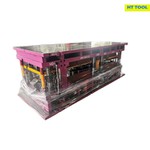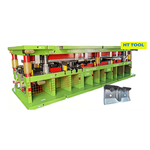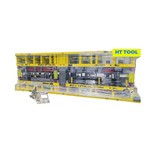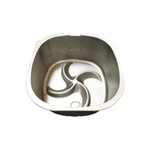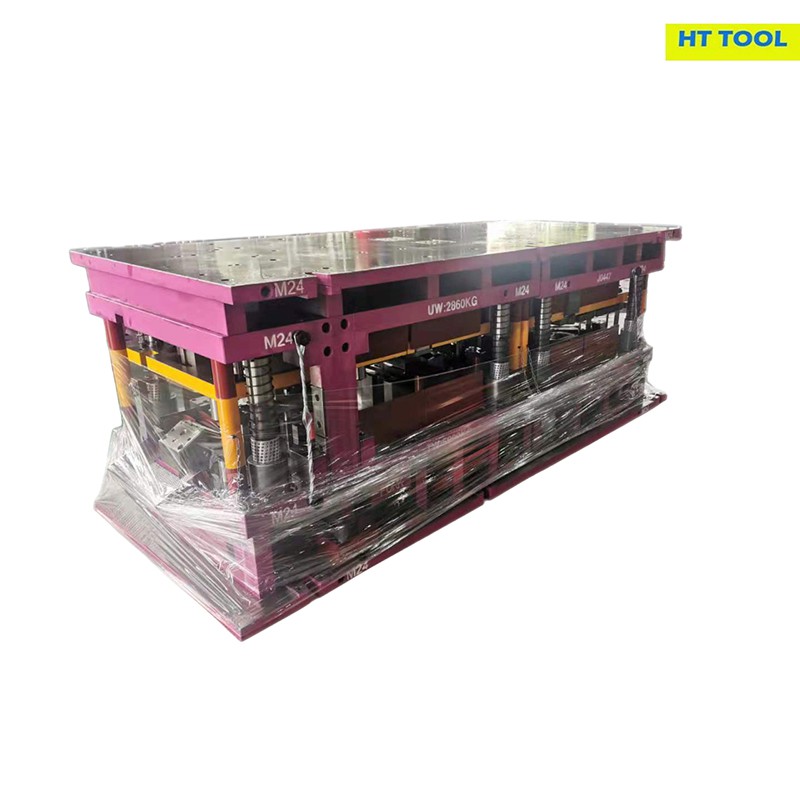Q: What is the working principle of metal tandem dies?
A: The working principle of metal tandem dies is based on integrating multiple processes into a single die system to achieve continuous processing. These dies typically consist of two or more different modules, each responsible for completing specific processing steps. In metal tandem dies, the processing process is divided into multiple stages, and parts are transported from one module to another through conveyors, robotic arms, or other automated systems.
Q: What are the advantages of tandem over traditional single dies?
A: 1. Process Integration: Metal tandem dies integrate multiple processes into a single die system. Each module is responsible for completing specific processing steps, such as stamping, bending, cutting, etc.
2. Continuous Processing Flow: Parts pass through different modules in the die system sequentially, completing various processing steps, thereby achieving a continuous processing flow.
3. Automated Conveyance: Parts are typically conveyed between different modules through conveyors, robotic arms, or other automated systems. This ensures the continuity and efficiency of the processing process.
4. Coordination and Synchronization: Coordination and synchronization between modules are necessary to ensure accurate positioning and precise processing of parts during the processing process.
5. Efficient Production: Metal tandem dies can significantly improve production efficiency by reducing the waiting time and transportation time of parts between different processing steps, thereby shortening the production cycle.
Q: What applications are tandem dies typically used for?
A: 1. Automotive Parts Manufacturing: Tandem dies are widely used in the automotive industry for producing car body components, engine parts, chassis components, etc.
2. Furniture and Home Appliance Manufacturing: In the home appliance industry, tandem dies are commonly used for producing washing machine bases, furniture connectors, tableware, kitchen utensils, etc.
3. Construction and Building Materials: Tandem dies can be utilized for producing building structural components, pipe fittings, etc.
4. Electronics Manufacturing: In the electronics industry, tandem dies can be used for producing mobile phone casings, laptop outer casings, tablet outer casings, etc.
Q: What are the materials used to manufacture metal tandem dies?
A: 1. Tool Steel: Tool steel is a common material used for manufacturing dies, characterized by excellent hardness, wear resistance, and heat resistance, suitable for applications requiring high precision machining and prolonged use.
2. Hard Alloy: Hard alloys have excellent hardness and wear resistance, commonly used for manufacturing die components that require wear resistance and corrosion resistance, such as cutting tools and cutting edges.
3. Engineering Plastics: For processing non-metallic parts, the manufacturing material of the die may be engineering plastics, such as polyamide (nylon), polycarbonate (PC), etc., which have good wear resistance and corrosion resistance.
4. Aluminum Alloy: For applications with high requirements for lightweight, aluminum alloy may be used as the manufacturing material for metal tandem dies, as it has good machinability and lightweight characteristics.
Q: If collaborating with HT TOOL, what is the design process of metal tandem dies?
A: 1. Requirement Analysis: Firstly, the design team needs to communicate extensively with the client to understand the product design requirements, processing needs, expected production volume, etc., to clarify design goals and constraints.
2. Detailed Design: After selecting the most suitable conceptual design, the design team begins detailed design work. This includes determining the specific dimensions, structure, component layout, transmission devices, fixtures, etc., to ensure that the die can meet processing requirements and expected performance.
3. CAD Modeling: Utilizing Computer-Aided Design (CAD) software to model the die, including the design of 3D models and 2D drawings. CAD modeling helps the design team better understand the structure and functionality of the die, and make necessary modifications and optimizations.
4. Simulation Analysis: Using Computer-Aided Engineering (CAE) software to perform simulation analysis on the die, evaluating its structural strength, stiffness, fatigue life, etc., identifying potential design flaws, and optimizing them.
5. Manufacturing and Assembly: Manufacturing the various components of the die and assembling them according to the design drawings and models. During the manufacturing process, it is necessary to ensure the accuracy and quality of the components to ensure the working performance of the die.
6. Trial Production: After completing the manufacturing and assembly of the die, conducting trial runs of the die to inspect its machining accuracy, stability, and reliability, and identifying and solving any potential issues.
7. Buyoff: After improvement and trial production, conducting final acceptance of the die to ensure it meets the client's requirements and standards. Upon completion of acceptance, delivering the die to the client for use.
Q: In the production process, how to ensure the coordination and cooperation between the hardware tandem dies?
A: 1. Precise design and manufacturing: During the design and manufacturing stages, ensure that the dimensions, clearances, and positions between each module are accurately matched to ensure coordination and cooperation between the dies.
2. Standardized interface design: When designing the dies, standardized interface design can be adopted to unify the connection methods between different modules, facilitating assembly and disassembly, and ensuring the accuracy and stability of connections.
3. Precision positioning and clamping systems: Consider using precision positioning and clamping systems in die design to ensure that parts can be accurately positioned and clamped in each module, thereby ensuring machining accuracy and stability.
4. Automated control systems: Using automated control systems enables precise control of coordination and cooperation between the dies. Real-time monitoring and adjustment of the positions and statuses between the dies through sensors, actuators, and other devices maintain their coordination and cooperation.
5. Real-time monitoring and adjustment: During the production process, monitor the working status and machining quality of the dies in real-time, promptly identify and adjust any inconsistencies between the dies to ensure smooth production.
Q: What are the production costs of metal tandem dies?
A: The production cost of metal tandem dies includes engineering design fees, material procurement costs, processing and manufacturing costs, among others. These costs mainly depend on factors such as the complexity, size, material selection, and manufacturing processes of the dies. After the dies are manufactured, trial production and debugging are usually required to ensure the performance and processing quality of the dies. The trial production and debugging process may involve higher costs, including labor, materials, and equipment adjustments. Regular maintenance and upkeep are necessary during use to ensure long-term stable operation. Maintenance and upkeep costs include expenses for parts replacement, lubricants, labor for maintenance, etc.
Q: What are the maintenance requirements for metal tandem
A: Maintenance requirements for metal tandem dies:
1. Regular cleaning and lubrication: Regularly clean the surface and internal components of the die, removing oil, metal chips, and other impurities to keep the die clean.
2. Component replacement: Periodically inspect key components of the die, such as guide pins, sliders, and guide posts, and promptly replace them if worn or damaged. Particularly for vulnerable components, such as cutting edges, they should be replaced regularly based on usage.
3. Corrosion and rust prevention treatment: For dies not in use for extended periods or exposed to humid environments, corrosion and rust prevention treatment is necessary.
4. Regular inspection and repair: Regularly inspect and repair the die comprehensively, identifying and addressing potential faults and issues.
5. Training and management: Provide training to operators, establish a sound die management system, maintain records of die usage and maintenance, facilitating timely identification of issues and implementation of solutions.
Q: Do different types of metal processing require customized tandem dies?
A: For different types of metal processing, it is often necessary to customize different tandem dies to adapt to variations in processing techniques, precision requirements, processing speeds and efficiencies, parts characteristics, and shapes. Customized tandem dies can better meet specific processing needs, improve processing quality, and enhance production efficiency.
Q: How efficient are tandem dies in batch production?
A: Tandem dies feature precise positioning and clamping systems, ensuring accurate positioning and stable processing of parts during the machining process, thereby improving accuracy and consistency. In batch production, tandem dies can enhance production efficiency by optimizing the machining process, reducing manual intervention, improving machining accuracy and stability, and thus increasing productivity. This efficiency improvement supports cost savings and enhances competitiveness for businesses.
Q: Are there any safety issues associated with the use of metal tandem dies?
A: Yes, there may be some safety problems in the process of using metal tandem dies, mainly including the following aspects:
1. Operation safety: When using metal tandem dies, operators need to comply with the operating procedures and safety operation norms to avoid accidents caused by improper operation.
2. equipment safety: the safety of the metal tandem dies equipment itself is also an important consideration, you need to make sure that the equipment is structurally sound and functional to reduce the risk of accidental injury.
3. Maintenance safety: regular maintenance and repair of metal tandem dies is an important measure to ensure their safe operation.
4. Material safety: The processing of metal tandem dies may involve some hazardous materials, such as metal dust, etc., which require appropriate protective measures to protect their health and safety.
5. Safety training: Providing relevant safety training and guidance for operators is the key to ensure the safe use of metal tandem dies, including training in operating skills, safety awareness training, emergency response and other aspects of training.
Q: What is the lifespan of metal tandem dies?
A: The lifespan of metal tandem dies is influenced by various factors, including material selection, design and manufacturing quality, frequency and load of use, maintenance, processing environment, and quality control. The design and manufacturing quality of the dies directly affect its lifespan. High-quality design and manufacturing can reduce fatigue damage and stress concentration, extending the dies's service life. Measures such as selecting materials reasonably, optimizing design and manufacturing, and regularly maintaining can prolong the lifespan of the dies, improve production efficiency, and economic benefits.
Q: What is the role of metal metal tandem dies in sustainable production?
A: Mainly in the following aspects:
1. Resource utilization efficiency: Metal metal tandem dies can integrate multiple machining processes into one dies system, achieve continuous processing flow, reduce energy and raw material consumption, and lower production costs.
2. Reduction of waste generation: metal tandem dies can minimize waste generation by optimizing the machining process and reducing the number of times parts need reworking, thereby reducing environmental pollution and resource wastage.
3. Energy conservation: metal tandem dies, with their continuous processing flow and optimized processes, also contribute to energy conservation by reducing energy wastage and enhancing energy utilization efficiency.
4. Improved product quality: metal tandem dies enable precise machining and stable production of parts, reducing the impact of human factors on product quality and enhancing product consistency and stability.
Q: How does the accuracy of metal tandem dies compare to progressive die?
A: 1. Accuracy of metal tandem dies: metal tandem dies integrate multiple machining processes into a single dies system, enabling continuous processing and reducing waiting and transportation times during machining. Typically utilizing automated equipment and equipped with precise positioning and clamping systems, metal tandem dies can achieve high machining accuracy, meeting the requirements for processing high-precision products.
2. Accuracy of progressive die: progressive die are a type of dies system that operates continuously, processing parts through multiple machining units. progressive die often have higher processing speeds and production efficiency. However, since parts undergo multiple machining units during processing, factors such as transfer errors and vibrations may affect machining accuracy.
In summary, both metal tandem dies and progressive die can achieve high levels of machining accuracy. However, due to differences in their operating principles and machining methods, their accuracy performance may vary.
Q: What are the common application areas of metal tandem dies?
A: 1. Automotive Manufacturing: metal tandem dies are widely used in automotive manufacturing for stamping body panels, doors, hoods, and other automotive components. Series-connected dies enable efficient continuous processing, thereby improving production efficiency and quality stability.
2. Appliance Manufacturing: metal tandem dies are also commonly used in the appliance manufacturing industry for products such as refrigerators, washing machines, air conditioners, etc.
3. Electronics Manufacturing: metal tandem dies find applications in the manufacturing of electronic products such as smartphones, tablets, computer casings, and other metal components. Series-connected dies facilitate efficient machining of precision metal parts to meet the production demands of electronic products.
4. Aerospace: The aerospace industry demands high precision and quality for components. metal tandem dies are also utilized in aerospace for manufacturing components like aircraft fuselages, engine parts, etc.
Q: Does metal tandem dies need to be redesigned for new metal materials or processes?
A: For the application of new metal materials or processes, metal tandem dies may need to be redesigned or adapted to meet the processing requirements and precision demands of the new materials. Therefore, when adopting new metal materials or processes, it is recommended to evaluate the existing dies designs and make adjustments and optimizations as necessary to ensure that the dies can effectively be used in the new processing methods.
Q: What is the applicability of metal tandem dies for high-temperature or high-pressure processing?
A: 1. Material Selection: Material selection is crucial for metal tandem dies used in high-temperature or high-pressure processing. It's essential to choose metals that are resistant to high temperatures and pressures, such as special alloys or high-temperature alloys, to ensure the stability and durability of the dies in such environments.
2. Structural Design: The structural design of metal tandem dies needs to consider working conditions under high temperatures or pressures, including factors like thermal expansion and deformation. It's necessary to design appropriate structures and material combinations to ensure the stability and reliability of the dies in high-temperature or high-pressure environments. 3. Cooling Systems: Effective cooling systems need to be designed for high-temperature processing to control the dies's temperature and prevent overheating damage. Internal or external cooling systems can be employed to reduce the dies's temperature, protecting its surface and structure.
In conclusion, metal tandem dies have certain applicability in high-temperature or high-pressure processing, but appropriate design and adjustments need to be made based on specific processing conditions and requirements.
Q: How to consider the durability and reliability of hardware tandem dies in the design stage?
A: Considering the durability and reliability of hardware tandem dies requires comprehensive consideration from various aspects such as material selection, structural design, surface treatment, cooling system design, parts selection, quality control and dies maintenance, etc. Considering these factors fully at the design stage can effectively improve the durability and reliability of the dies, reduce the cost of maintenance, and improve the production efficiency.
Q: What are the advantages of the combination of hardware tandem dies and CNC machining technology?
A: The combination of hardware tandem dies and CNC machining technology has many advantages, including:
1. High-precision machining: CNC machining technology can realize high-precision machining, and the combination of hardware tandem dies can realize continuous high-precision machining of partss to ensure the precision and consistency of products.
2. Flexibility: CNC machining technology can flexibly adjust the machining path and machining parameters, combined with hardware tandem dies can achieve flexible processing of different partss, improving the flexibility and adaptability of production.
3. automated production: CNC machining technology realizes the automatic control of the machining process, combined with hardware tandem dies can realize the automatic control of the machining process, improve the production efficiency and stability.
4. Cost reduction: the combination of CNC machining technology and hardware tandem dies can reduce labor costs and energy consumption.
5. Quality control: CNC machining technology and hardware tandem dies have good quality control ability, which can monitor and adjust the machining process in real time to ensure that the quality of the product meets the requirements.
Q: What are the future development trends of metal tandem dies?
A: The future development trends of metal tandem dies may include the following aspects:
1. Intelligence and Automation: With the advancement of artificial intelligence and automation technologies, metal tandem dies may become increasingly intelligent and automated. For example, the integration of smart sensors and control systems could enable real-time monitoring and adjustment of the machining process.
2. Digital Manufacturing: The development of digital manufacturing technologies will drive metal tandem dies towards digitalization and networking.
3. Green Manufacturing: The promotion of green manufacturing principles will encourage the development of metal tandem dies towards environmental protection and energy saving. For example, adopting energy-efficient and environmentally friendly processing technologies and materials to reduce energy consumption and environmental pollution.
4. Material and Process Innovation: Continuous innovation in new materials and processing technologies will drive the development of metal tandem dies. For instance, the use of new materials to enhance the wear resistance and corrosion resistance of dies, and the adoption of advanced processing technologies to improve machining accuracy and efficiency.
5. Collaborative Robot Technology: The application of collaborative robot technology will change traditional production modes. metal tandem dies may be combined with collaborative robots to achieve flexible production and human-machine collaboration, thereby enhancing production efficiency and flexibility.





